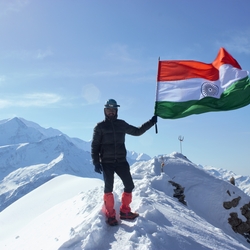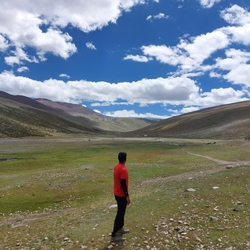You might think otherwise but humans started scaling mountains pretty early in the historical timeline, especially given the lack of infrastructure and technology at that point of time. Documented examples of ascents or even just attempted ascents date as far back as 1336! Although attempts on the big guns, the Himalayas, only started later on, peaks in other mountain ranges across the world were being conquered. In 1786, the very first summit of Mont Blanc by Jacques Balmat and Michel-Gabriel Paccard marked the birth of mountaineering as a sport and is till date considered as an epochal event in mountaineering history. What initially started off for political, economic or religious purposes gradually evolved into a sport with defined techniques and specialised equipment made to support climbers. There was a growing desire to explore the natural world and unchartered territories, which fueled the growth of mountaineering.
This article explores the different styles of mountaineering and common climbing techniques followed by mountaineers across the world along with some fun facts from mountaineering history!

Styles of Mountaineering
Broadly speaking, there are two main styles of mountaineering; Alpine style and Expedition style.
Alpine Style
Alpine style or variations of it typically involves no backtracking, with a single and straightforward push to the summit. This means climbing with limited gear, food, ration and giving up on the comforts of warmth, sleep and nourishment to reach the top. The term ‘alpine’ originates from the Alps where in the 1800s, mountaineers climbed classic routes with one tent and a backpack on their back, and moved camps as they went up and down the mountain. Mountaineers following this style of climbing do not change camps if the summit can be reached in a single day. Given the pace of the ascent, alpine style of mountaineering leaves less time for acclimatisation. Supplementary oxygen is rarely used in this style and loads are restricted to a minimum to aid a fast ascent. Climbers rarely rely on fixed ropes (wherever avoidable), which are common in expedition style of mountaineering. All these characteristics also make it one of the most dangerous forms of climbing. This style of climbing is mostly suited and is also common on mid-sized mountains with an elevation ranging between 2000 m-5000 m and are located close to civilization, like the Rockies or the Alps.
Although alpine style climbing is not common in the Himalayas, mountaineers have successfully summited major peaks in the Himalayan range using this style. The Northwest face of Gasherbrum I was successfully climbed in pure alpine style by Reinhold Messner and Peter Habeler in 1975. This was also the first ascent of an 8000 m using alpine style, shattering the belief that they could only be climbed in expedition style. Years later, Nives Meroi and Romano Benet climbed all 14 eight-thousanders in alpine style, without any support or supplementary oxygen.

Expedition Style
In a complete contrast to alpine style, expedition style involves carrying large quantities of equipment, food and ration up and down the mountain, while making slow progress towards the summit. Typically, expedition style of mountaineering has a big team of climbers along with porters and guides who support their climb. Mountaineers set up multiple camps along their route to the top and carry the loads from one camp to another over multiple rounds until all the gear and ration is at the higher camp. This process is referred to as ‘load ferry’ and is repeated until they complete their ascent. Load ferrying also acts as an excellent technique to ensure proper acclimatisation, thus reducing a climbers’ chances of developing altitude sickness. Climbers resort to fixed lines to avoid the dangers of frequent movement between camps. Expedition style involves the use of supplementary oxygen on the 8000 m mountains and is safer given the availability of food and equipment to survive a long lasting storm. However, the slow pace of this style and longer exposure to the dangerous terrain also puts climbers at the risk of other risks like avalanche and rockfall.
Expedition style is highly suitable in the Himalayan ranges which are extremely remote and also present dangerous climbing conditions. To put things into perspective, while Mont Blanc was first summited in 1786, the first 8000 m peak was only successfully summited in 1950, which speaks volumes of the difficulty level involved in climbing an eight-thousander. Maurice Herzog and Louis Lachenal climbed the peak of Annapurna in 1950, making it the first recorded successful ascent of an eight-thousander. Most of the major attempts and successful summits on the 8000 m peaks have been carried out in expedition style.
Expedition style can be further broken down into guided and self-supported. In a guided climb, climbers are accompanied by an operator or guide who organises the climb for them. Loads are carried with the help of porters and pack animals. They also provide equipment and gear on hire. Self-supported expeditions are carried out by climbers and mountaineers on their own after obtaining necessary permits. They carry their load and make their way to the summit pitching multiple camps on the way.


Common Climbing Techniques
Different terrains warrant the use of different climbing techniques and procedures. Following are a few common techniques used by mountaineers:
Rope Up
This technique refers to the process of roping up with other climbers for protection and safety while traversing on a glacier or a steep slope on the way to the summit. It acts as a safety mechanism if and when a climber slips and falls into a crevasse or down a slope by allowing the other climbers to self-arrest and act as an anchor. The team of climbers then work together to rescue the climber who has fallen. Roping up is common on terrain where a climber believes that they will not get the required protection from crampons and footwork. While deciding the order of the rope-up team, it is important to remember that the climber with least experience should be placed in the middle, the climbers with experience in navigation and route finding should be in the front helping traverse around crevasses and the biggest person in the team should be leading during the ascent and should be tailing while descending. When you are moving as a rope team, keep in mind to match the pace of your fellow climbers and avoid leaving slack or loose rope which will take longer to arrest in case of a fall.

Fixed Ropes
Fixed ropes are used in expedition style mountaineering in steep and icy sections of a route. A group of mountaineering guides fix ropes for other climbers to use during their expedition. Static or semi-static nylon rope is secured to a sturdy piece of ice or rock on the mountain and climbers use it as a support system or as a ladder while they move up and down a particular section of the mountain. The use of fixed ropes provides a safety mechanism to climbers on high altitude climbs where a small misstep could cost them their lives. Climbers attach themselves to the fixed line with a mechanical ascender, where the ascender cam locks onto the line in the event of a fall. All guided expeditions to the eight-thousanders set up fixed lines for climbers on steeper sections of the route. For example, the use of fixed lines is common at Hillary Step on Mt. Everest. Hillary Step is an extremely technical portion of the mountain that results in a bottleneck of climbers right below the summit. Today, the guides and Sherpas of Nepal who carry loads and fix ropes play a crucial role and are pretty much the backbone of mountaineering in Nepal. Without them, expeditions of numerous mountaineers would be impossible.

Aid Climbing
Aid climbing involves the use of specialised equipment on extremely steep and long routes that demand high levels of endurance and stamina. During a climb, aid climbers place protection equipment in the cracks or other features of a rock or ice, then clip a stirrup, which is a ladder-like device to the protection equipment and pull themselves up with the help of the stirrup or aider. This process is repeated to progress upwards on a steep mountain slope. Until the 1940s, pitons were typically used as protection equipment which were screwed into the cracks with a hammer. With the development in mountaineering gear and technology, mountaineers today use a wide array of equipment including copperheads, camming devices, ascenders, and nuts along with pitons. While aid climbing was normal practice until the 1960s, mountaineers including Reinhold Messner criticised the use of aid, stating that the development in climbing techniques and equipment allowed for aid free climbing and the continuing use of aid went against the spirit of mountaineering. Currently, a number of routes that were earlier climbed using aid climbing are being climbed free by climbers with improvised techniques, equipment and remarkable physical abilities.

These styles and techniques of climbing were not developed overnight or over a single attempt to scale a mountain. The evolution of modern day climbing, techniques and equipment took place over hundreds of years with climbers trying and testing different styles and methods to efficiently summit a mountain. In this process, there were attempts that ended in success and also attempts where a number of mountaineers lost their lives. K2, also known as the world’s deadliest mountain, for its ruthless and unforgiving weather conditions, was only summited in 1954 by an Italian team. Lino Lacedelli and Achille Compagnoni reached the summit of K2 after numerous unsuccessful attempts by mountaineers across the world. The mountain is also known to have taken the lives of many mountaineers and poses long technical stretches for a climber to tackle. In this period of evolution, a few mountaineers also attempted what was thought to be impossible and set a new record in the history of mountaineering. Reinhold Messner became the first person to scale all 14 eight-thousanders without the use of supplementary oxygen. It is no easy task to have climbed all of them when equipment and techniques were still being developed and understood by a majority of the climbers.
Sometimes styles and techniques are mixed together by mountaineers to achieve optimal outcomes or even as safety procedures. The sport continues to evolve with the technological developments that produce better equipment resulting in more efficient and easier techniques for climbing. This also means that mountaineering has now become accessible to everyone and scaling Mt. Everest is no longer associated with the wow factor it once was given the rate at which operators are taking climbers on guided expeditions. This has also led to increased waste accumulation on the mountains, either in the form of plastic or fixed ropes left by climbers season after season. Regardless of your choice of expedition style or climbing techniques, it is important to climb these mountains in a sustainable and eco-friendly manner.
If you wish to know more or have any queries regarding mountaineering styles, techniques or maybe even some history, feel free to reach out to our team.






